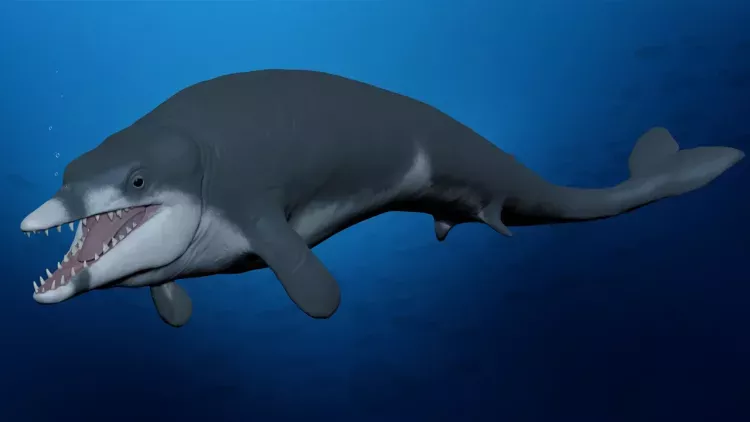Fossil triggers monumental change in our comprehension of whales' evolutionary history
Researchers from Egypt have announced the finding of one of the smallest early whales known to science. This discovery also marks the oldest fully aquatic whale found in Africa, according to a recent study.
With an estimated weight of 412.3 pounds (187 kilograms) and a length of 8.2 feet (2.5 meters), this newly documented species is roughly the size of a modern-day bottlenose dolphin.
Named Tutcetus rayanensis, this creature belonged to the extinct basilosauridae family, which was one of the earliest groups to become fully aquatic. As revealed in a study published in Communications Biology on Thursday, this diminutive specimen is considerably older than other basilosaurids from the Eocene Epoch.
The fossils and their implications
The Eocene Epoch, spans from approximately 55.8 million to 33.9 million years ago and dates dates back about 41 million years. This fossil find comprises an incomplete skull with jaws, the hyoid apparatus (tongue base bones) and the uppermost vertebra of a small subadult, all embedded in limestone.
This fossil discovery has led to the identification of a new genus within the basilosauridae family. The name "Tutcetus" is a combination of "Tutankhamen" (the young Pharaoh) and "cetus" (the Greek word for "whale").
According to lead author Mohammed S. Antar, a paleontologist at the Mansoura University Vertebrate Paleontology Center in Egypt, "The discovery of the new basilosaurid whale, Tutcetus rayanensis, has brought about a substantial shift in our understanding of cetacean life histories during the Eocene epoch."
Interestingly, unlike previous findings among basilosaurids, there are indications that despite its relatively small size, the subadult T. rayanensis (and possibly other basilosaurids) could have experienced rapid growth.
Antar suggested that they "might have undergone faster developmental processes than previously believed, suggesting a diverse range of growth strategies within this group."
This discovery has implications for the evolutionary tree and sheds light on previously misunderstood aspects.
Nicholas Pyenson, a paleobiologist at the Smithsonian National Museum of Natural History in Washington, DC, noted, "The discovery 'helps clarify parts of the evolutionary tree and pushes back some of the changes we thought were happening.'"
Moreover, T. rayanensis sets itself apart from other basilosaurids by not replacing its first premolar tooth. Antar said that this unique trait added "another dimension to our understanding of basilosaurid whales and their evolutionary adaptations."

Reconstruction of Tutcetus rayanensis. Connor Ashbridge. CC BY-SA 4.0
Whales in the desert
The fossil of this whale was unearthed in the Wadi El-Rayan area, located about 24.9 miles (40 kilometers) northeast of Egypt's Wadi Al-Hitan World Heritage Site in the Western Desert. This region is renowned as one of the most productive fossil whale sites globally, providing a fertile ground for paleontological exploration.
As scientists continue their work in the Wadi El-Rayan area, there is a possibility of finding even earlier fully aquatic whale species.
Co-author Erik R. Seiffert, a professor at the University of Southern California’s Keck School of Medicine, noted that their analysis suggested the transition to a fully aquatic lifestyle could have occurred a few million years earlier than Tutcetus' age, although conclusive fossil evidence is still lacking.
This discovery represents a significant achievement for Egyptian and African paleontology, signifying a departure from historical practices. Hesham Sallam, a professor at the American University in Cairo and founder of the Mansoura University Vertebrate Paleontology Center, led the study, further bolstering Egypt's position in the field of paleontology and scientific research.
























